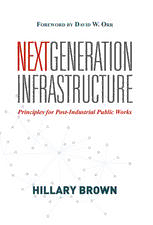
Next Generation Infrastructure: Principles for Post-Industrial Public Works PDF
Preview Next Generation Infrastructure: Principles for Post-Industrial Public Works
F D W. O OREWORD BY AVID RR NEXTGENERATION INFRASTRUCTURE PPrincipleessss ffor Post-Industrial Public Works HILLARY BROWN Next Generation Infrastructure Next Generation Infrastructure Principles for Post-Industrial Public Works By Hillary Brown Washington | Covelo | London Copyright © 2014 Hillary Brown All rights reserved under International and Pan-American Copyright Conventions. No part of this book may be reproduced in any form or by any means without permission in writing from the publisher: Island Press, 2000 M Street NW, Suite 650, Washington, DC 20036 Island Press is a trademark of The Center for Resource Economics. Island Press would like to thank Furthermore, a program of the J. M. Kaplan Fund, for generous support of the design and printing of this book. Library of Congress Cataloging-in-Publication Data Brown, Hillary. Next generation infrastructure / Hillary Brown. pages cm Includes bibliographical references and index. ISBN 978-1-59726-805-9 (hardback)—ISBN 1-59726-805-4 (cloth)—ISBN 978-1-61091-181-8 (paper) 1. Infrastructure (Economics)—Environmental aspects—United States. 2. Infrastructure (Economics)—Government policy—United States. I. Title. HC110.C3B76 2014 363.60973--dc23 2013039889 Printed on recycled, acid-free paper Manufactured in the United States of America 10 9 8 7 6 5 4 3 2 1 Keywords: biomass, bioremediation, carbon reduction, climate change adaptation, climate change mitigation, coastal resilience, distributed energy systems, geothermal energy, green streets, hydrogen power, infrastructural ecology, renewable energy, siting public utilities, smart grid, solar power, storm-water management, urban resilience, waste combustion, water scarcity, waste-to-energy facilities, water treatment and storage For Jeanne and George Contents Foreword by David W. Orr ........................................................................................................................ xi Acknowledgments ..................................................................................................................................... xv Chapter 1. Introduction: Bold Endeavors Needed ................................................................ 1 Chapter 2. Toward Infrastructural Ecologies: Interconnected, ....................................... 17 Multipurpose, and Synergistic Systems Chapter 3. Greening Heat and Power: An Integrated Approach to .............................. 41 Decarbonizing Energy Chapter 4. Advancing Soft-Path Water Infrastructure: Combined ............................... 69 Constructed and Natural Systems Chapter 5. Destigmatizing Infrastructure: Design of Community-Friendly ............. 97 Facilities Chapter 6. Creating Resilient Coastlines and Waterways: Hard and Soft .............. 127 Constructions Chapter 7. Combating Water Stress and Scarcity: Augmented Sources and ........ 149 Improved Storage Chapter 8. Ways Forward: Think Systematically, Experiment Locally ....................... 171 Notes ............................................................................................................................................................ 199 Index ............................................................................................................................................................. 233 ix Foreword David W. Orr An hour north of New York City, the Omega Institute operates a solar-powered wastewater system that looks and works like a tropical greenhouse. It was designed by John Todd and BNIM Architects to process 50,000 gallons of wastewater each day. The system combines indoor and outdoor wetlands to purify sewage without chlorine, aluminum salts, or other chemicals, and without fossil fuels. Plants, animals, and some of the most ancient organisms on Earth remove nitrogen and phosphorus from the waste stream and detoxify contaminants. It is a model of smart ecological design, good engineering, full-cost econom- ics, and foresight. But the Omega Institute facility is only one small example of next-generation design applied to energy, water, transport, and waste-management systems. There are many others around the world that are revolutionizing infra- structure, reducing costs, and improving resilience, as reported here by Hillary Brown. Our existing infrastructure of wastewater plants, bridges, the electrical grid, pipelines, roads, and dams is rapidly deterio- rating. The American Society of Civil Engineers estimates that its repair or replacement will cost $3.6 trillion. For financial rea- sons alone it is a good time to rethink the way we design, build, and invest in public infrastructure. But the design assumptions underlying our existing infrastructure are crumbling along with the concrete, steel, wires, and pipes. The designers of the industrial infrastructure presumed an inexhaustible supply of cheap energy, the efficacy of simple and single-purpose solu- tions to complex problems, and the necessity of brute-force mastery of nature, all executed with a bulletproof confidence in endless economic growth on a finite planet. The fatal short- comings of that paradigm are massively documented and are becoming a daily bad-news story in our increasingly precarious experience. xi
